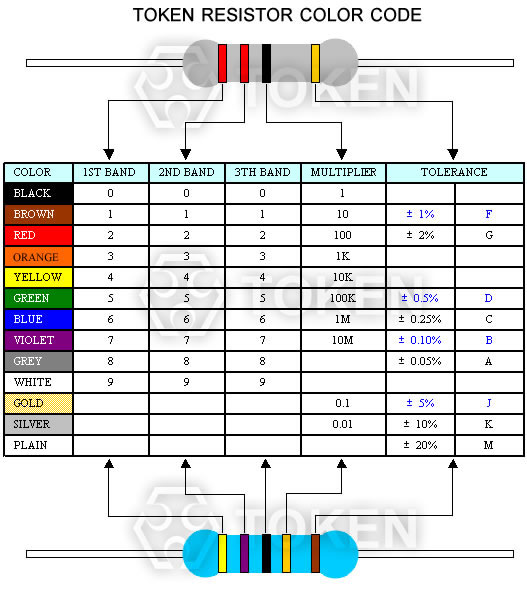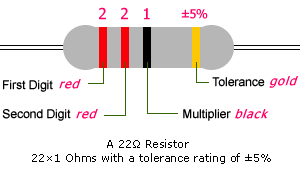RESISTOR COLOR CODE
Resistor Code

TOKEN RESISTOR COLOR CODE
Resistance Tolerance
| Symbol | A | B | C | D | F | G | J | K | M |
| Resistance tolerance | ±0.05% | ±0.1% | ±0.25% | ±0.5% | ±1% | ±2% | ±5% | ±10% | ±20% |
How To Read The Resistor Code
- First find the tolerance band, it will typically be gold (5%) and sometimes silver (10%).
- Starting from the other end, identify the first band - write down the number associated with that color; in this case Red is 2.
- Now 'read' the next color, here it is red so write down a 2 next to the two. (you should have '22' so far).
- Now read the third or 'multiplier' band and write down that number of 1.
- In this example, the 'multiplier' band is Black so we get 22 Ω.
- If the 'multiplier' band is Gold move the decimal point one to the left.
- If the 'multiplier' band is Silver move the decimal point two places to the left.

Token Resistor Color Coding System
Token resistor color coding system applies to carbon film, metal oxide film, fusible, precision metal film, and wirewound (cylindrical with enlarged ends) of the axial lead type. This system is employed for resistors when the surface area is not sufficient to print the resistance value for the past time.
At present, Token resistor color coding system is applying for automatization. The first three bands closest to one end of the resistor are used to determine the resistance. The fourth band represents the tolerance of the resistor. Additional information can be obtained from the first band.
Generally, If an additional fifth band is black, the resistor is wirewound resistor. If an additional fifth band is white, the resistor is fusible resistor. If only one black band in the center, the resistor is called zero ohm resistor. The colors of the first two bands represent the numerical value of the resistor. The third band represents the power-of-10 multiplier.
PDF Catalogue Download
Download complete PDF file - Resistor Color Code And Nominal Resistance Table.
Significant Figures of Nominal Resistance
| E-6 Resistance Tolerance (±20%) | |||||||||||
| 10 | 15 | 22 | 33 | 47 | 68 | . | . | . | . | . | . |
| E-12 Resistance Tolerance (±10%) | |||||||||||
| 10 | 12 | 15 | 18 | 22 | 27 | 33 | 39 | 47 | 56 | 68 | 82 |
| E-24 Resistance Tolerance (±2%; ±5%; ±10%) | |||||||||||
| 10 | 11 | 12 | 13 | 15 | 16 | 18 | 20 | 22 | 24 | 27 | 30 |
| 33 | 36 | 39 | 43 | 47 | 51 | 56 | 62 | 68 | 75 | 82 | 91 |
| E-96 Resistance Tolerance (±1%) | |||||||||||
| 10.0 | 10.2 | 10.5 | 10.7 | 11.0 | 11.3 | 11.5 | 11.8 | 12.1 | 12.4 | 12.7 | 13.0 |
| 13.3 | 13.7 | 14.0 | 14.3 | 14.7 | 15.0 | 15.4 | 15.8 | 16.2 | 16.5 | 16.9 | 17.4 |
| 17.8 | 18.2 | 18.7 | 19.1 | 19.6 | 20.0 | 20.5 | 21.0 | 21.5 | 22.1 | 22.6 | 23.2 |
| 23.7 | 24.3 | 24.9 | 25.5 | 26.1 | 26.7 | 27.4 | 28.0 | 28.7 | 29.4 | 30.1 | 30.9 |
| 31.6 | 32.4 | 33.2 | 34.0 | 34.8 | 35.7 | 36.5 | 37.4 | 38.3 | 39.2 | 40.2 | 41.2 |
| 42.2 | 43.2 | 44.2 | 45.3 | 46.4 | 47.5 | 48.7 | 49.9 | 51.1 | 52.3 | 53.6 | 54.9 |
| 56.2 | 57.6 | 59.0 | 60.4 | 61.9 | 63.4 | 64.9 | 66.5 | 68.1 | 69.8 | 71.5 | 73.2 |
| 75.0 | 76.8 | 78.7 | 80.6 | 82.5 | 84.5 | 86.6 | 88.7 | 90.9 | 93.1 | 95.3 | 97.6 |
| E-192 Resistance Tolerance (±0.1%; ±0.25%; ±0.5%) | |||||||||||
| 10.0 | 10.1 | 10.2 | 10.4 | 10.5 | 10.6 | 10.7 | 10.9 | 11.0 | 11.1 | 11.3 | 11.4 |
| 11.5 | 11.7 | 11.8 | 12.0 | 12.1 | 12.3 | 12.4 | 12.6 | 12.7 | 12.9 | 13.0 | 13.2 |
| 13.3 | 13.5 | 13.7 | 13.8 | 14.0 | 14.2 | 14.3 | 14.5 | 14.7 | 14.9 | 15.0 | 15.2 |
| 15.4 | 15.6 | 15.8 | 16.0 | 16.2 | 16.4 | 16.5 | 16.7 | 16.9 | 17.2 | 17.4 | 17.6 |
| 17.8 | 18.0 | 18.2 | 18.4 | 18.7 | 18.9 | 19.1 | 19.3 | 19.6 | 19.8 | 20.0 | 20.3 |
| 20.5 | 20.8 | 21.0 | 21.3 | 21.5 | 21.8 | 22.1 | 22.3 | 22.6 | 22.9 | 23.2 | 23.4 |
| 23.7 | 24.0 | 24.3 | 24.6 | 24.9 | 25.2 | 25.5 | 25.8 | 26.1 | 26.4 | 26.7 | 27.1 |
| 27.4 | 27.7 | 28.0 | 28.4 | 28.7 | 29.1 | 29.4 | 29.8 | 30.1 | 30.5 | 30.9 | 31.2 |
| 31.6 | 32.0 | 32.4 | 32.8 | 33.2 | 33.6 | 34.0 | 34.4 | 34.8 | 35.2 | 35.7 | 36.1 |
| 36.5 | 37.0 | 37.4 | 37.9 | 38.3 | 38.8 | 39.2 | 39.7 | 40.2 | 40.7 | 41.2 | 41.7 |
| 42.2 | 42.7 | 43.2 | 43.7 | 44.2 | 44.8 | 45.3 | 45.9 | 46.4 | 47.0 | 47.5 | 48.1 |
| 48.7 | 49.3 | 49.9 | 50.5 | 51.1 | 51.7 | 52.3 | 53.0 | 53.6 | 54.2 | 54.9 | 55.6 |
| 56.2 | 56.9 | 57.6 | 58.3 | 59.0 | 59.7 | 60.4 | 61.2 | 61.9 | 62.6 | 63.4 | 64.2 |
| 64.9 | 65.7 | 66.5 | 67.3 | 68.1 | 69.0 | 69.8 | 70.6 | 71.5 | 72.3 | 73.2 | 74.1 |
| 75.0 | 75.9 | 76.8 | 77.7 | 78.7 | 79.6 | 80.6 | 81.6 | 82.5 | 83.5 | 84.5 | 85.6 |
| 86.6 | 87.6 | 88.7 | 89.8 | 90.9 | 92.0 | 93.1 | 94.2 | 95.3 | 96.5 | 97.6 | 98.8 |